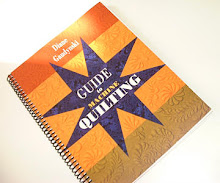 Sometimes we sit and stare, ponder, and dither, and finally the best option for difficult fabrics is to simply listen to them. Instead of countering the design they have, it’s not a bad idea to work with these designs by using them as the basis of a quilting motif.
Sometimes we sit and stare, ponder, and dither, and finally the best option for difficult fabrics is to simply listen to them. Instead of countering the design they have, it’s not a bad idea to work with these designs by using them as the basis of a quilting motif.The photo, above, shows a soft double zig-zag line of quilting on the bright yellow fabric in a challenge quilt I did last spring. Each border had the print positioned a bit differently as I wasn’t planning on using it as my quilting guide.
So each border was quilted with this design but was just a bit different. It all merged wonderfully and looked just fine.
It is fairly easy to use the fabric print as your guide, parts of it as positioning points in creating a freehand quilting design. I quilted freehand, stayed within the area I used in the print, and worked along steadily, looked ahead of the needle to the lines of the fabric itself, and yes, I had to take breaks to rest my eyes every now and then as it gets a bit dizzying doing this kind of quilting. But it went quickly and was fun to do.
 This example, above, is another of the fabrics in this quilt and even though I tried some marked Diane-shiko on it as a small sample, I went with this freehand design that was 1) simple, 2) fast, and 3) effective.
This example, above, is another of the fabrics in this quilt and even though I tried some marked Diane-shiko on it as a small sample, I went with this freehand design that was 1) simple, 2) fast, and 3) effective. It showcased the design of this gaphic fabric, it created a new dimension for the fabric, and added a new layer of design. It did not interfere, get lost, or take over. It was quite fun and easy to do. I finished all 4 borders in an hour or so.
And I didn’t have to mark it or try to see marks as I quilted or remove marks later.
The marked Diane-shiko I thought would look so wonderful was difficult to mark, impossible to see, and the final quilted sample looked pretty boring. I mean, really boring. You couldn’t see the quilting, and the fabric design was obscured. It was an exercise in the wrong design for the wrong fabric with the wrong result.
Don’t worry about switching your ideas while working on a quilt. Always try a sample of the quilting you plan on the fabric itself. Not only do you warm up and get into that design before you do it on the actual quilt, but you can see right away if it works into all the necessary requirements for being “the right design” for this area, this fabric, this quilt.
I have become far more flexible after years of quilting and have learned to listen to the quilt, to the fabric. It’s good to try something different than the same old, same old.
Keep quilting; your work indeed will get better every day!
Diane










 How to hold the quilt in the machine for the best control and ease of quilting is an individual thing. We all find our “comfort zones” that will give us good grip and control, and still have ease of moving the quilt, plus no strain on our bodies.
How to hold the quilt in the machine for the best control and ease of quilting is an individual thing. We all find our “comfort zones” that will give us good grip and control, and still have ease of moving the quilt, plus no strain on our bodies.  Instead try relaxing your shoulders like Barbara, above, keeping your elbows down, and yes you many times do have to concentrate on that as many are completely unaware of their bird-like body positions while they quilt. It’s best of course to be able to rest your forearms much of the time on the surround or cabinet, on the quilt itself, and move the quilt with your hands, lightly touching the quilt and moving it easily.
Instead try relaxing your shoulders like Barbara, above, keeping your elbows down, and yes you many times do have to concentrate on that as many are completely unaware of their bird-like body positions while they quilt. It’s best of course to be able to rest your forearms much of the time on the surround or cabinet, on the quilt itself, and move the quilt with your hands, lightly touching the quilt and moving it easily. 











 Quilter Blogs & Store Search
Quilter Blogs & Store Search